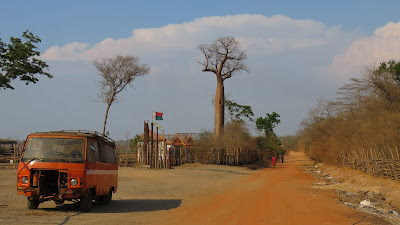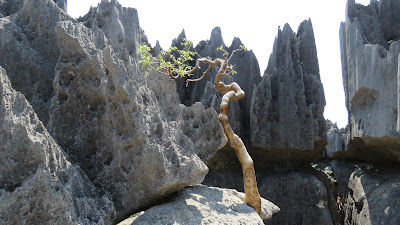After the rain, the road conditions had deteriorated.
Red Fronted Lemurs.
The baobab 'In Love'.
Baobab Alley at sunset.
Two great guys: Patrick our driver and Morgan our guide.
Tuesday,
November 1st.
I was
woken up as usual by the village cockerel. He starts at 4 am before
it gets light, by beating his wings and then letting rip with
'cock-a-doodle-do'. He is answered by others near and far. We were up
for an early breakfast, and then said goodbye to our hosts at Camp
Croco. Patrick had stayed on the north side of the river to get the
4x4 fixed, which was a relief to all of us and meant that we could
use the aircon again.
Now
we had the long and arduous return journey to Morondava. The long
drive back to the Tsiribihina River was made more interesting by the
rain from last night. There were big puddles and small lakes in the
road at in places the dirt and dust had become muddy and slippery,
which slowed us down a bit. Luckily after a couple of hours the water
disappeared as it didn't rain that far south. When we arrived at the
Tsiribihina River Patrick drove the truck back on the ferry and we
sailed up river for an hour and across to the other side.
Since
we didn't see the fosa when we visited the Kirindi Forest on the way
north, Morgan took us there on the return trip hoping to find it. I
think it hangs around the local garbage dump there, like bears, but
again we had no luck. However, we did see a number of Red Fronted
Lemurs in the trees. We watched them as they fed and jumped from tree
to tree. I also saw a few beautiful birds including the male and
female Paradise Flycatcher. Then Morgan found another group of the
lemurs nearby. Because of the presence of tourists they have become
habituated and will come down out of the trees for water. This was
amazing! We poured water into the lid of a water bottle and they
would come down, hang off a tree or branch, gently grab your hand with their soft fingers and
lap up the water. Great to see them up close and not have to wrench
your neck looking up.
Then
we continued on to The Sacred Baobab. This is the largest baobab in
the area and has special meaning for the locals. There was a fence
around it and you had to remove your shoes to approach it. There were
other baobabs in the area too.
The
next stop was at the Baobab 'In Love'. This is a really odd tree as
two baobab tree trunks have grown intertwined. It has also become a
significant tourist stop with several little souvenir shops. I feel
sorry for the locals who are trying to sell stuff to us that we don't
want or need.
Finally
we arrived at Baobab Alley about an hour before sunset. We parked and
then were free to walk around the area. I watched several children
who had chameleons on sticks for tourists to photograph for money.
There were many other tourists here as this has become a very popular
place since it was granted temporary protected status in 2007 by the
Ministry of the Environment, Water and Forests, the first step to
making it Madagascar's first natural monument.
Baobab
trees, up to 800 years old, known locally as renala
(Malagasy
for "mother of
the forest"), are a legacy of the dense tropical forests that
once thrived on Madagascar. The trees did not originally tower in
isolation over the serene landscape of scrub but stood in dense
forest. Over the years, as the country's population grew, the forests
were cleared for agriculture, leaving only the baobab trees, which
the locals preserved as much in respect as for their value as a food
source (they eat the fruit) and building material.
The
area is not a national park, and the trees are threatened by further
deforestation, effluence from encroaching rice paddies and sugarcane
plantations, and bush and forest fires.
Despite its popularity as
a tourist destination, the area has no visitor centre or gate fees,
and local residents receive little income from tourism. Indeed
there are local people living in huts in among the trees. The
children beg for 'bonbons', money or to have their photos taken for
money. I couldn't help
think of how the local people feel about a bunch of tourists showing
up every night to photograph the sunset and then leave. They live a
basic, subsistence life and they watch as tourists arrive daily, and
then drive away to get to the Tsingy National Park.
When
the sun finally set we, and all the other tourists, got back in our
4x4's and left. Our next stop was a the ATM in Morondava to get money
for tips and the rest of the trip. And finally we stopped at Morgan's
house to meet his family. This was really special as he was very
pleased to introduce us to his five children, aged 18 to eighteen
months (she was an accident he said). We also met his wife.
Unfortunately as it was dark and late we could not stay for a good
visit. Morgan and Patrick also wanted to get back home to their
families, so they drove us back to Chez Maggie's where we started
this trip. We said our thanks, gave them their tips, arranged with
Patrick for a drive to the airport in the morning and they left.
When
we got back Stuart was there waiting for us as he said he would.
Margaret and I went for dinner with him to a local restaurant and
Ryan and Sarah went to a pizza place. That ends the first part of the
Madagascar journey.



























































